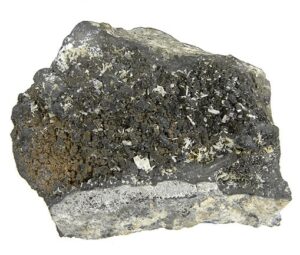
Contrary to gold, encountering silver in a pure metallic form is extremely rare. Most silver occurs in ores containing a mix of metals, most commonly lead, zinc, nickel and/or copper. As a consequence, these ores have to undergo refining in order to extract pure silver.
This wasn’t any different in the Bronze Age. You have got to hand it to these early metallurgists, they were very resourceful. As early as the early third millennium, silver was extracted from lead ores by means of a complicated process. First, the ores had to be heated in a reducing atmosphere so that the metals are extracted from their base rock and form an alloy, a process called ‘smelting’.
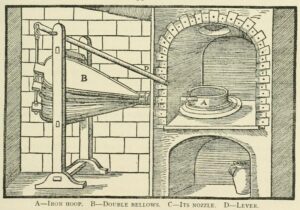
Smelting is more than just ‘melting the metal out of its ore’. Most silver ores are a chemical compound of several metals bound to other elements, such as oxygen (as an oxide), sulfur (as a sulfide) or carbon and oxygen together (as a carbonate).
In order to get rid of the sulfur and carbon, the ores have to be crushed and then ‘roasted’ which means that they are heated for prolonged periods of time under moderate temperatures. This happens in an oxidizing environment so that the sulfur and carbon react with the oxygen and are driven off as the gases carbon dioxide and sulfur dioxide. The roasting will leave us with our metals bound to oxygen only. The next step is to get the oxygen to free the metal.
In order to achieve this these oxides have to be heated to high temperatures in a reducing atmosphere. This means that the flow of oxygen is eliminated or, at least, limited in the furnace while the metal is surrounded by an element that readily binds with oxygen, such as carbon in the form of charcoal. When this is performed properly the oxides will undergo a chemical reaction. The oxygen from the oxides will form carbon dioxide with the carbon provided by the charcoal and the metals will form a metallic alloy.
Finally, this alloy has to be ‘cupelled‘. The result of this method is an almost pure silver as long as no gold was present in the ore. Ancient silver does contain trace elements, typically lead, gold, bismuth and other metals and measuring the concentrations of these ‘impurities’ can help the forensic jewelry historian in determining the authenticity of classical items.
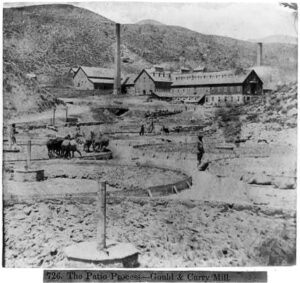
The general process of mining-crushing-roasting-reducing-cupelling lead-silver ores remained the main method of silver extraction for thousands of years. It wasn’t until halfway through the 15th century that liquation started to be used to extract silver from silver-copper ores. This technique has been extensively used in Central Europe from the Middle Ages until the late 19th century. In order to separate the silver from the copper, the ore is first melted while adding lead. Silver has a higher affinity to lead than copper so will bond with the lead. After melting the ore a few times so that most of the silver has teamed up with lead rather than with the copper the mix is heated to above the melting point of lead but below that of copper. The silver-rich lead can then be drained off, leaving behind pure copper, and cupelled to separate the two metals.
In 1554 mercury amalgamation started to be used. The discovery of mercury amalgamation has been attributed to a Spanish merchant, Bartolomé de Medina, who was the first to apply the technique to silver ores in Spanish America. The method comprises the crushing of the ore to a fine powder and then mixing it with salt, water, copper sulfate and mercury in a basin in which it is left for prolonged periods of time while being stirred constantly. This causes the silver to form an alloy with mercury: a so-called amalgam. This would be separated from the rest of the sludge and then heated in order to drive off the mercury, leaving the miner with pure silver. This process is better known as the Patio Process, later improved to become the Pan Amalgamation Process.
Silver Mining
Bronze-Age – Turkey & Armenia
When silver mining truly started isn’t known exactly but slag heaps in modern-day Turkey and Armenia indicate that some silver extraction from lead ores must have occurred here as early as the 4th millennium BC. From here silver refining technology spread to the rest of Asia Minor and Europe.
Classic Era – Greece & Spain
As written above, the main occurrence of silver is in lead ores. The first real silver mining areas, those of Anatolia (Turkey, from around 2500BC ) and later Laurium (Greece, from around 1000BC) formed no exception. Since high doses of lead inevitably will kill those who are exposed to it, silver mining soon became a sector worked by slaves, something which remained the case for many centuries. The Phoenicians, a seafaring and trading culture originally from the Lebanese and Syrian coasts discovered the Spanish deposits around the year 800BC. By 700 BC their explorations had yielded so much silver that it depressed the value of silver bullion throughout the entire Classical world.
Having access to silver deposits and being able to mine them played a big role in the classical world. Silver was used as a currency in Athens since 580 BC so being able to mine it literally contributed to the wealth of the city. Many historians have argued that it was the possession and exploitation of the Laurium mines by the Athenians that allowed them to become the most powerful city-state in Greece (see map in next section of this article for the location of these mines).

The Athenians were well aware of the significance of the mining operations to the prosperity of their city. This becomes obvious from studying records that show many citizens had shares in the mines. In 512BC the Persians overran the silver mines in northern Greece, leaving the Athenians to depend solely on the mines at Laurium, something which triggered an increase in further exploration of the deposit. In 483-482 BC, a large new vein was found at the site and the Athenian leader Themistocles persuaded the citizens to forgo their usual dividend from the mine so that the city could use the money to build a large fleet. This fleet made a crucial difference at the battle of Salamis where it defeated the Persians and paved the way for their domination of Ancient Greece.
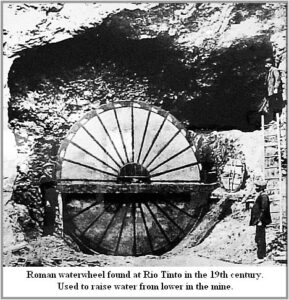
As big a role as the Laurium mines played in the uprising of Athens in the 5th century BC, they played even bigger in the downfall of the city-state. When, during the Peloponnesian War, the Spartans stationed an army near Athens, the slaves who worked the mines fled en mass. Athens was cut off from its war fund and eventually lost the war to Sparta. The Laurium mines were worked for some time after that but eventually became depleted and the main Greek silver production shifted to mines in Macedonia.
For the Romans, whose stability of currency also depended mainly on silver, the mines in Spain’s southeast became the main source of the metal. These mines, initially exploited by the Roman arch-enemy, Carthage, after the First Punic War, fell into Roman hands after the defeat of Carthage in the Third Punic War and enabled Rome to further expand its empire. When, in 55 BC, the Romans invaded Britain they were quick to discover and exploit the lead-silver deposits there. Only six years later they had established many mines and Britain became another major source of silver.
Middle Ages – Central Europe
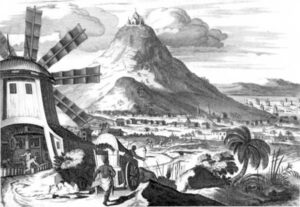
The demise of the Roman Empire caused havoc and destruction to the whole of Europe and consequently, organized silver mining on a scale practiced in Classical times became impossible. From around the 8th century AD silver mining in Europe picked up again, especially in Central Europe resulting in more intensive mining during the rest of the Middle Ages.
1500-1800 – South & Central America
The discovery of America in 1492 heralded major changes in the magnitude of the world’s silver production. In 1546 the Potosí mines in Bolivia and the Cerro de la Bufa mines in Mexico were discovered. Both deposits contained vast amounts of silver-quantities of ore which were unheard of in Europe. Over the centuries after ‘the Conquest’ numerous other deposits were located and mined in South and Central America, fueling the treasury of the Spanish crown and enabling it to lead a dominating role in Europe.
One of the most remarkable localities in the Americas was that which became known as Planchas de Plata near what is now Nogales at the border of Mexico and the US. There, native silver, and a fair bit of it too, was found in placers. There have been reports of slabs weighing more than 2500 pounds!
1800-1900 – North America
The first silver deposit in the USA was found in North Carolina, northeast of Charlotte. Named Silver Hill for obvious reasons, this deposit was worked from 1838 on. Some 20 years later gold prospectors mining a gold placer in western Nevada were annoyed by what they called ‘blue mud’. The sticky clay was a nuisance to these men, clogging their sluices and making getting around a hard task. In 1859 a rancher by the name of B.A. Harisson sent a sample of this blue mud to an assayer in California who found out that it was loaded with silver, over $3000 of it per ton! The richest silver ore ever found was being thrown away by men desperately looking for a few flakes of gold.
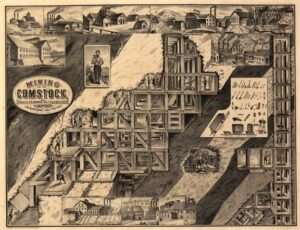
As soon as the news spread, claims were staked and silver mining at what has become known as the ‘Comstock Lode’ began. Miners moved to the area in great numbers and settled in what would become Virginia City. In 1863 this was a bustling town counting 10.000 residents. For the next 20 years, this deposit yielded enormous amounts of silver.
Although it is mainly the Gold rushes that have become famous, silver has often left a much deeper footprint in the history of the areas in which it was mined than gold has. A typical gold rush would last anywhere from a few months to a few years but after the alluvial gold was mined, prospectors would leave the area leaving their make-shift structures behind to become ghost towns. Silver regions, however, would see a much longer habitation since the metal isn’t mined from placer deposits but has to be extracted from ores which lie at greater depths and occur in greater quantities. Because silver mining towns would see prosperity for several decades rather than a few years, they could develop into more complex and advanced communities, thus giving the towns a greater chance of survival after the silver had been mined out. This is not only true for the mining towns but also for the ports close by. Take San Francisco for example, which wasn’t just built on gold from the Sierra’s, but to a large extent on silver from the Comstock Lode. In terms of a long-term effect on the civilization of an area, gold has played a much lesser role than silver.
Silver can further pride itself on a huge effect on technological advances in the field of mining. Gold mining, until recent times, has often been a surface engagement. Since miners would just extract the gold from placer deposits rudimentary techniques were sufficient. How different it was for silver miners! Silver-lead ores, often occurring in veins, would be chased to great depths, thus posing miners with every problem imaginable. The solutions to these problems changed mining indefinitely. Techniques first applied in silver mines proved to aid the entire industry and these technological novelties were soon applied in other mining sectors. A great example of this is the so-called honeycomb structure method of supporting large ballrooms (the word used by miners to indicate large underground chambers, see image above). This method is said to have been invented by a miner working the Comstock Lode in Nevada who got his inspiration from looking at bees while pondering on how to prevent further cave-ins.
1900 – Present
Over the last century mining technology and extraction methods greatly benefited from the invention of electricity and the combustion engine. These days silver mining has become a highly advanced sector. The top five silver-producing countries in 2010 were Mexico, Peru, China, Australia, and Chile. Other major producers are Bolivia, the USA, Poland, Russia Argentina and Canada.
